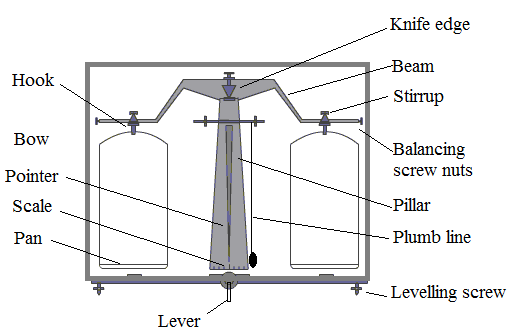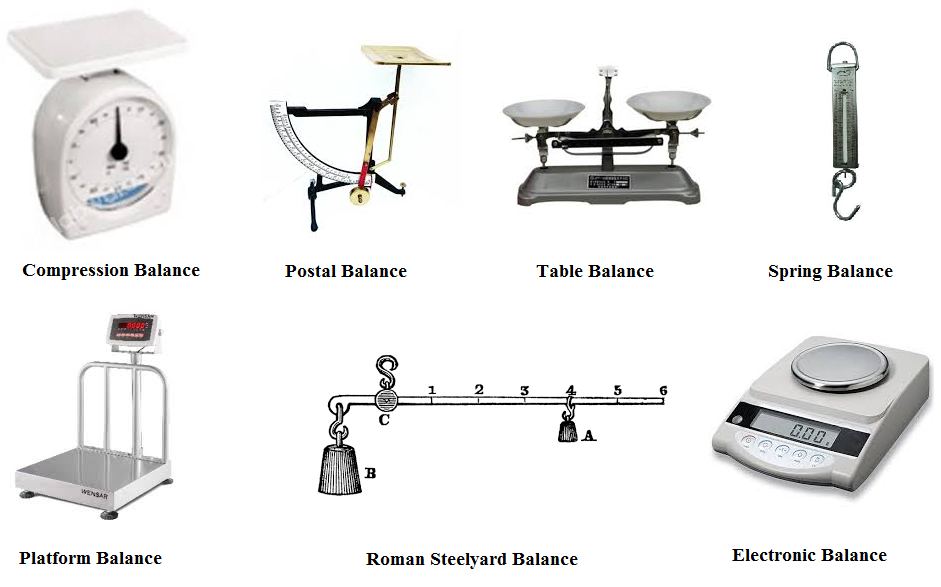Science > Physics > Units and Measurements > Measurement of Mass and Weight
In previous articles, we have studied measurements of length, area, and volume by different methods. In this article, we shall study the measurement of mass and weight of a body.
Measurement of Mass of a Body:
Mass is a measure of matter contained in a body. More the substance more the mass. Mass is a measure of the inertia of the body. Thus more mass the body has, the more it resists any effort to move it. S.I. unit of mass is the kilogram (kg). Its c.g.s. unit is gram (g). Mass is a scalar quantity.
one kilogram is a mass of a cylindrical piece made up of platinum-iridium alloy kept in the International Bureau of Weights and Measures at Sevres near Paris in France.
Common balance or physical balance are mostly used devices for the measurement of mass. Spring balance, table balance, platform balance, roman steelyard, triple beam steelyard are a few of the other types of balance.
Measurement of Mass by Use of Beam Balance:
Working Principle:
A beam balance works on the principle of moments. According to the principle of moments at equilibrium, the anti-clockwise moment due to the weight of an object on the left pan of the beam is equal to the clockwise moment due to the standard weights on the right pan of the beam.

Construction:
The physical balance consists of a light and rigid beam of brass, a metallic pillar, a wooden base, two pans, a metallic pointer, and an ivory scale. The plumb-line indicates whether the balance is horizontal. In an ideal condition, the plumb-line is aligned with the end of the knob fixed to the pillar. When the beam is horizontal the pointer remains on zero mark on the ivory scale. The device is enclosed in a glass box to avoid the effect of wind. The whole box has leveling screws at the bottom to set it horizontal. A lever arrangement is provided at the baseboard for raising or lowering the beam by raising and lowering of the platform. A weight box containing standard weights comes with the balance.
Use of Beam Balance:
Common balance is used to find unknown mass by using known standard masses.
- By adjusting levelling screw the plumb line is brought just above the pointed projection on the balance.
- The beam is raised using the lever and checked that the pointer swings equally on either side of the zero mark.
- Now, beam is lowered and an unknown mass is kept in one pan of the common balance.
- Next known masses are put in the second pan such that the pointer lies at the centre (zero mark) or the scale swings equally on both sides of the zero mark.
- The total known mass in the other pan is calculated, which gives the mass of the object.
Measurement of Mass of a Liquid or a Gas:
- Use the beam balance to find the mass of empty beaker or closed container. Note the Mass M1 kg.
- Fill the beaker with the liquid or the closed container with gas.
- Find the mass of the beaker with the liquid or the closed container with gas, Note this mass M2 kg
- Then M2 – M1 gives the mass of the liquid or the gas.
Requisite of Good Balance:
- A balance is considered to be true if its beam remains horizontal when equal weights or no weights are placed on the two pans. It is possible when the arms of the two balances are of equal length, the weights of two pans should be equal. The centre of gravity of the pan beam should pass through the fulcrum when the beam is horizontal.
- The balance should be sensitive. It should show a large deflection for a small difference in weights present in the two pans. It can be achieved by increasing the length of the arms of the beam.
- A beam balance should be stable. It should return to equilibrium conditions after being disturbed. It can be achieved by making the beam heavy.
- The beam of the balance must be made up of metal which is rigid so that there is no deformation in it.
- It is to be noted that a balance cannot be sensitive and stable at the same time as the condition required for sensitivity is that the centre of gravity of the beam along with the pans etc. must be near to the fulcrum, while the condition for stability is that the centre of gravity of the beam along with pan should be below fulcrum and at large distance from it. These two conditions are opposite to each other hence compromise between the sensitivity and stability is made.
Precautions in Using a Beam Balance:
- The weights should be carried with forceps. They should not be carried with bare fingers to avoid the change in its weight due to the presence of moisture and dust particles.
- The weights and the body whose mass is to be measured should be dry.
- When the pointer is near zero mark, the weights should be tried in the descending order.
- The beam should be lowered each time before adding or removing weights from the pan.
- The weight should be kept back into the weight box after using it.
- The lever should be turned gently, in order to prevent the knife edges from breaking.

Weight of a body:
The gravitational force of attraction (pull) exerted by the Earth on a body is called the weight of the body. It is a vector quantity. S.I. unit of weight is newton (N). It is measured using a spring balance.
The weight of a body is given by
W = mg
Where, m = mass of a body g = acceleration due to gravity
As the acceleration due to gravity ‘g’ changes from place to place and from planet to planet, the weight of the body is not constant. On the Earth, the value of acceleration due to gravity ‘g’ is the least on the equator and the highest on the poles. Hence the weight of the body on the equator is a least while the weight of the same body on the poles is the highest. In our planet system, the acceleration due to gravity on Jupiter is the highest. Hence the weight of a body on Jupiter is the highest.
Measurement of Weight of a Body:

Weight of a body is measured using a spring balance. A spring balance has a spring inside. A hook is attached to this spring which hangs down the body of the spring balance. The object to be weighed is suspended from the hook and weight is indicated on the graduated scale.
The spring balance works on the principle which states that the weight of the body attached to the hook of the spring balance is directly proportional to the extension of the spring. Thus more the weight more the extension and less the weight, less is the extension. Due to this relation, the graduated scale of the spring balance is linear.
Note: When we use beam balance we compare the weight of the body with standard weights. In this case, actual measurement of weight is not done.
Check the Validity of Following Statements.
“An astronaut whose mass is 84 kg on the earth will have an approximate mass of 14 kg on the moon”
This statement is not correct because mass remains constant. It does not change with a place.
“An astronaut whose weight is 840 N on the earth will have an approximate weight of 140 N on the moon”
This statement is correct because of the weight changes with a place. It depends on the acceleration due to gravity at that place. The acceleration due to gravity on the surface of the moon is about that on the surface of the earth. Hence the weight of the astronaut on the moon should be about that on the surface of the Earth. of 840 N is 140 N.
An object is weighed in the following places using a spring balance. At which place will it weigh the heaviest.
a) on the moon b) at the equator c) at the poles d) in space
- The acceleration on the surface of the moon is about that on the surface of the earth. Hence the weight of the astronaut on the moon should be about that on the surface of the Earth.
- On the earth itself, the acceleration is not the same everywhere. It is the highest at poles and the lowest at the equator. Thus on the surface of the earth, the weight of a body is more at poles than that at the equator.
- In space the acceleration due to gravity is negligible. Thus the weight of a body in the space is negligible i.e. almost zero. Thus the body will weigh the heaviest on the poles of the Earth.
Example – 01:
An object placed on an equal arm balance requires 12 kg to balance it. When placed on a spring scale, the scale reads 12 kg. Everything with measuring setup is transported to the Moon where free fall acts one-sixth that on the Earth. What will be the new readings of the equal-arm balance and the spring scale?
Explanation:
When we use beam balance we compare the weight of body with standard weights. Thus on the moon also the process is that of comparison. Hence the equal arm balance will show the same reading as that on the Earth i.e. 12 kg.
When we use spring balance we actually measure the weight of the body. The weight of a body at a place depends on the acceleration due to gravity at that place. On the Moon, the free fall acts one-sixth that on the Earth. i.e. the acceleration due to gravity on the surface of the moon is about that on the surface of the earth. Hence the weight of the body on the moon should be about that on the surface of the Earth. of 12 kg is 2kg (force).
Previous Topic: Measurement of Areas and Volumes
Next Topic: Measurement of Density